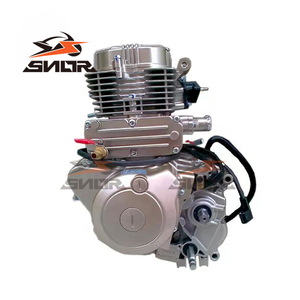(17224 products available)


























































































































































































125cc engines are available in two major types: four-stroke and two-stroke.
Four-stroke 125 cc engine
The four-stroke 125 cc engine is also called the four-cycle engine. It converts fuel into energy using four distinct strokes. The strokes include the intake stroke, compression stroke, power stroke, and exhaust stroke. During the intake stroke, the piston moves down and creates a vacuum that draws air and fuel into the cylinder. After that, the piston moves up in the compression stroke to compress the air and fuel. The compressed air and fuel are ignited in the power stroke, which pushes the piston down. Finally, the piston moves up in the exhaust stroke to expel the exhaust gases. The cycles repeat every four strokes. As a result, the four-stroke 125 cc engine is more fuel efficient and has better torque. It also produces fewer emissions and is quieter. However, the engine has a lower power output and is heavier.
Two-stroke 125 cc engine
In a two-stroke engine, the power stroke occurs every two strokes. The piston moves up and down in the cylinder two times. This allows the two-stroke 125 cc engine to generate a power stroke with every crankshaft rotation. The two-stroke 125 cc engine has a simple design with fewer components. The engine is lighter and cheaper to manufacture. As a result, the two-stroke 125 cc engine generates higher power. However, the engine has high emissions and noise levels. The two-stroke 125 cc engine is less fuel efficient and has low torque.
Here are the specifications of the 125cc engine that buyers can find in most portable generators:
Cylinder Bore:
This refers to the internal engine cylinder diameter where the piston moves up and down. The bore size of a 125cc engine is between 50 to 60 mm.
Cylinder Stroke:
It is the distance that the piston moves up and down in the cylinder. The stroke length for most 125cc engines is between 50 to 60 mm.
Number of cylinders:
Most 125cc engines have one to four cylinders. However, the number of cylinders in an engine affects how it runs and not how powerful it is.
Compression Ratio:
It is the ratio of the volume of the cylinder and the fuel in the cylinder during the power stroke to the volume of the cylinder and fuel in the cylinder at the end of the power stroke. The compression ratio for a 125cc engine is between 7.5 to 10.
Cooling System:
Most 125cc engines have air cooling systems. This means air moves around the engine to keep it cool.
valve configuration:
There are over-head valves in most 125cc engines. The over-head valves improve the performance of the engine.
Here are some tips for maintaining the 125cc engines:
Choosing the right 125cc engine for a business can be a daunting task. Here are some factors to consider;
Replacing a 125cc engine can be a straightforward process, provided that the right tools are available. Here is a step-by-step guide on how to replace a 125cc engine.
Before starting the process, here are the tools and materials that will be needed:
Step-by-step guide
Step 1:
Safety first. Ensure that the bike is on a flat surface. Wear safety glasses and gloves. Disconnect the battery before starting the process.
Step 2:
Drain the oil and coolant from the old engine. Make sure to dispose of the fluids according to local regulations.
Step 3:
Use a socket and wrench set to remove the engine from the bike. This may take some time since the engine is held in place by several bolts.
Step 4:
Now, use an engine hoist or lift to remove the old engine from the bike. Follow the manufacturer's instructions to avoid damaging the bike or injuring oneself.
Step 5:
Place the new 125cc engine onto the engine hoist or lift. Follow the manufacturer's instructions to install the new engine. Connect the bike's electrical system to the new engine using wire connectors and electrical tape.
Step 6:
Use a torque wrench to tighten the bolts that hold the engine in place. Refer to the bike's service manual for the correct torque specifications.
Step 7:
Fill the new engine with oil and coolant. Follow the manufacturer's instructions for the correct type and amount of fluids.
Step 8:
Reconnect the battery and start the engine. Let it run for a few minutes, then check for leaks and ensure everything works properly.
Q1: Are 125cc engines good?
A1: Yes, 125cc engines are good and suitable for many applications. However, their suitability depends on the specific use case. In general, 125cc engines are good for small tasks like powering mopeds, motorcycles, lawn equipment, and outboard motors. They offer fuel efficiency and are easy to maintain.
Q2: How fast can a 125cc engine go?
A2: A 125cc engine can go from 60 to 70 mph depending on various factors such as road conditions, wind resistance, and the weight of the rider.
Q3: Can I upgrade my existing 125cc engine?
A3: Yes, it is possible to upgrade the existing 125cc engine. This can be done by increasing the engine's displacement, which in turn increases the power output. This can also be done by improving the engine's efficiency through modifications.